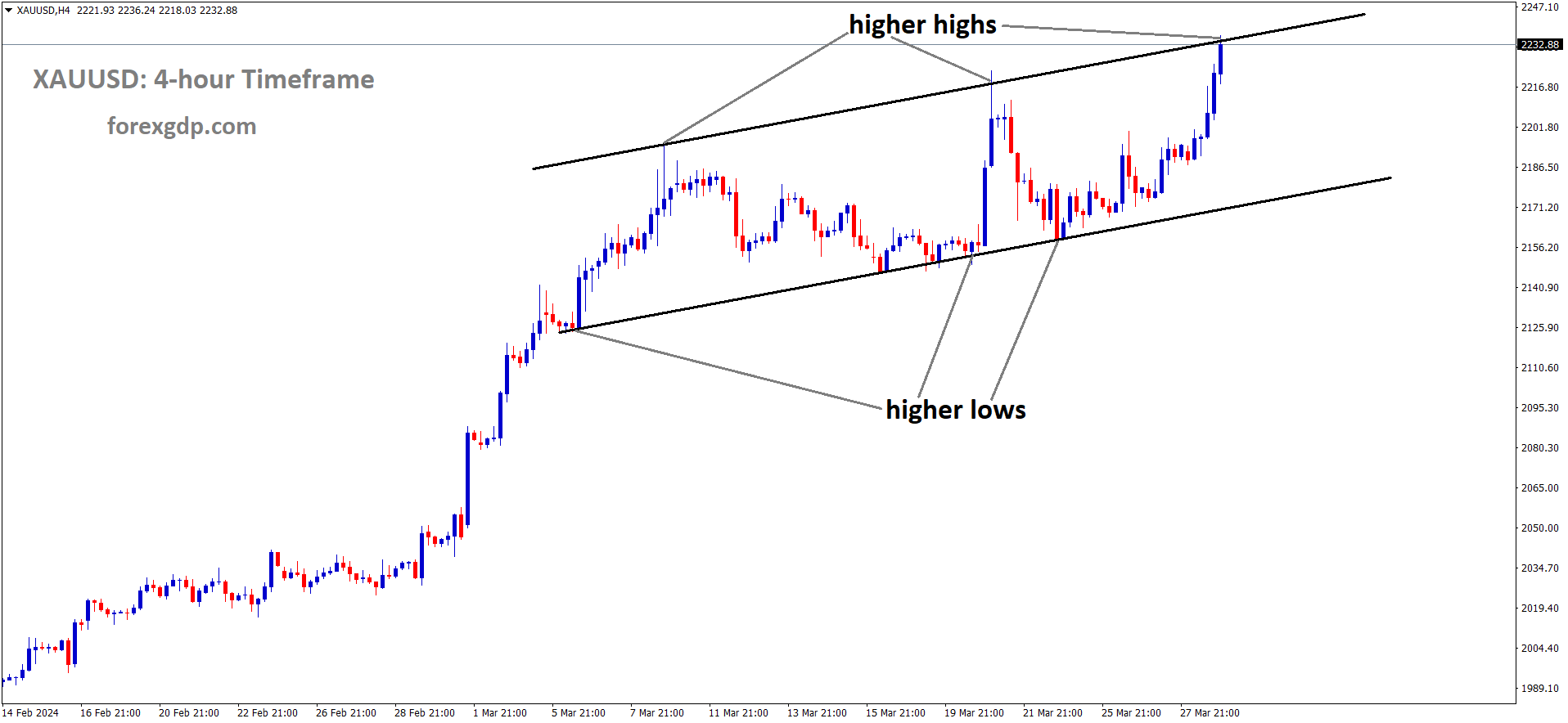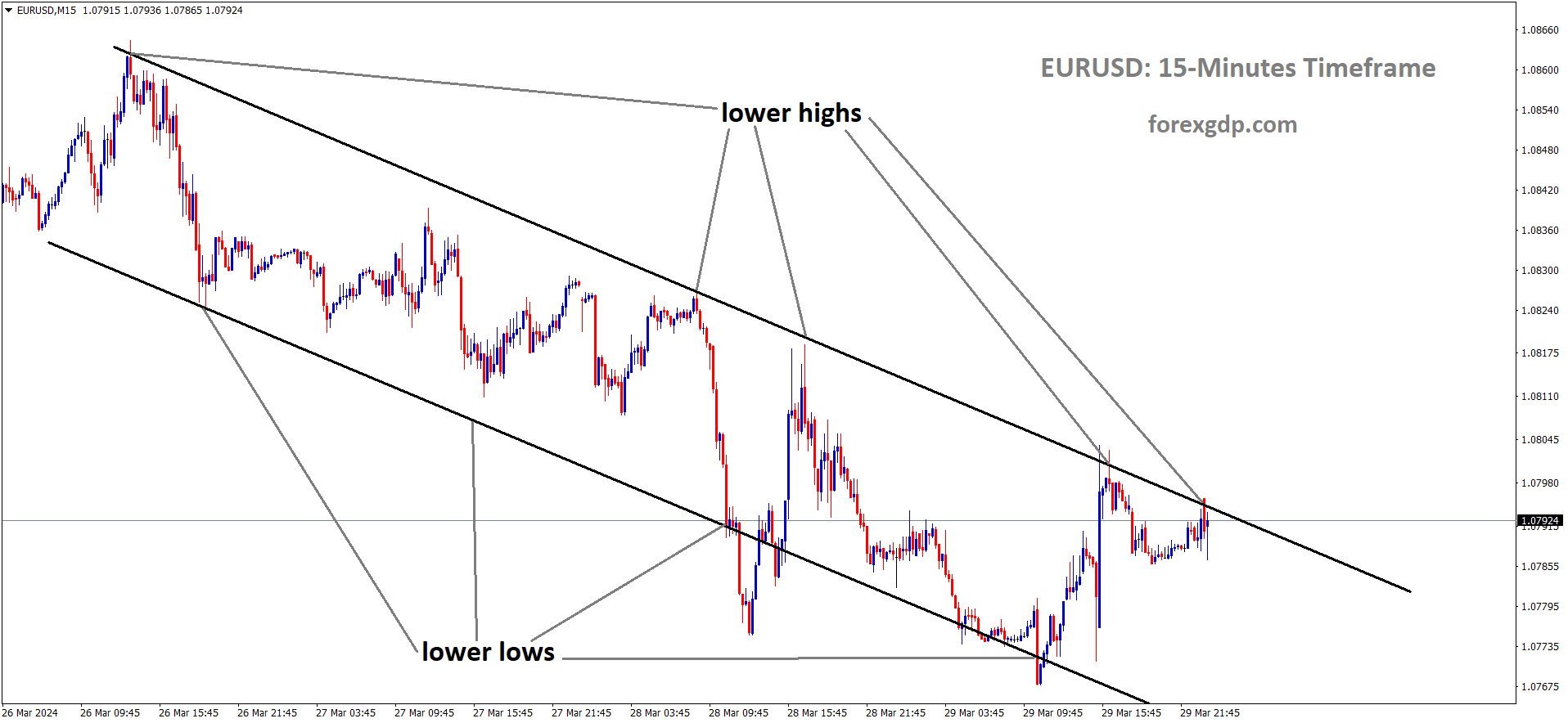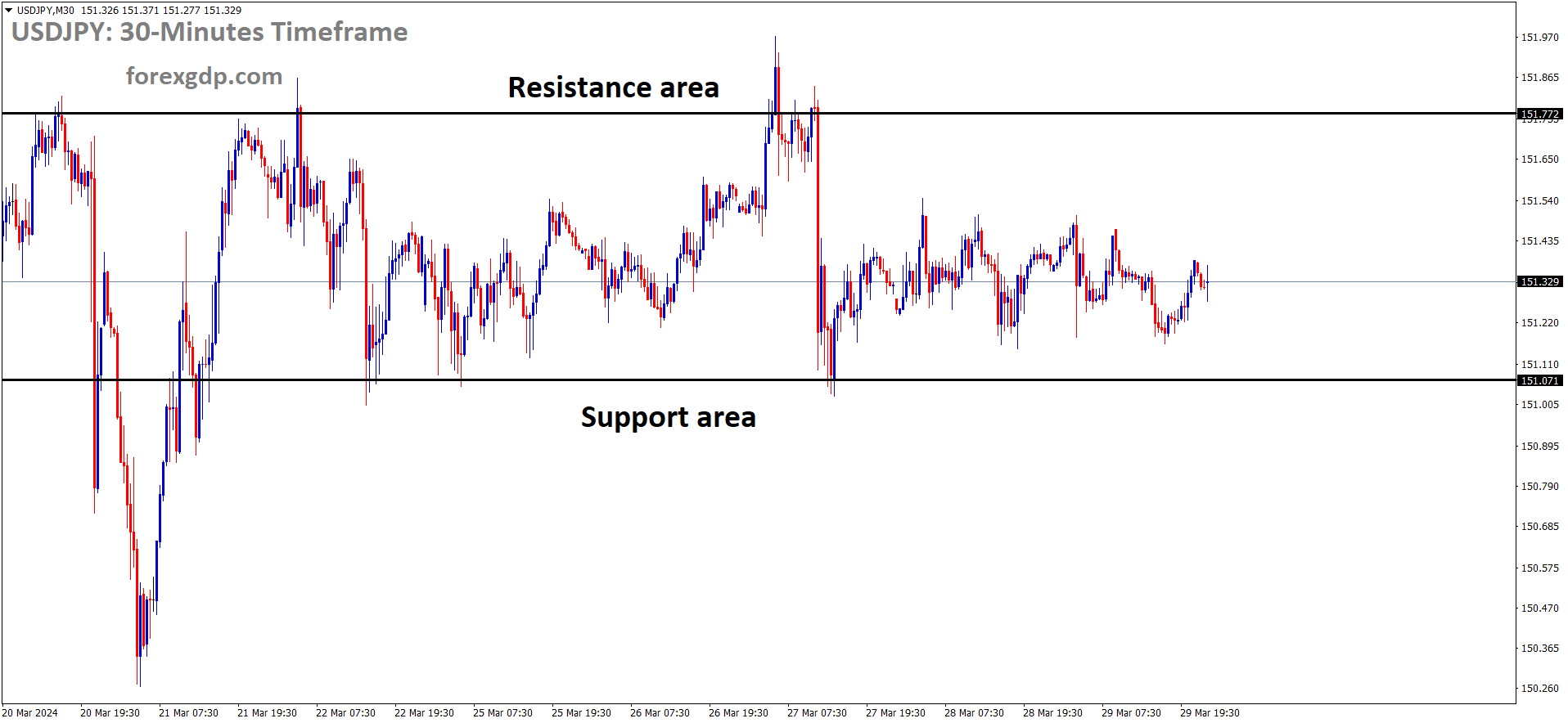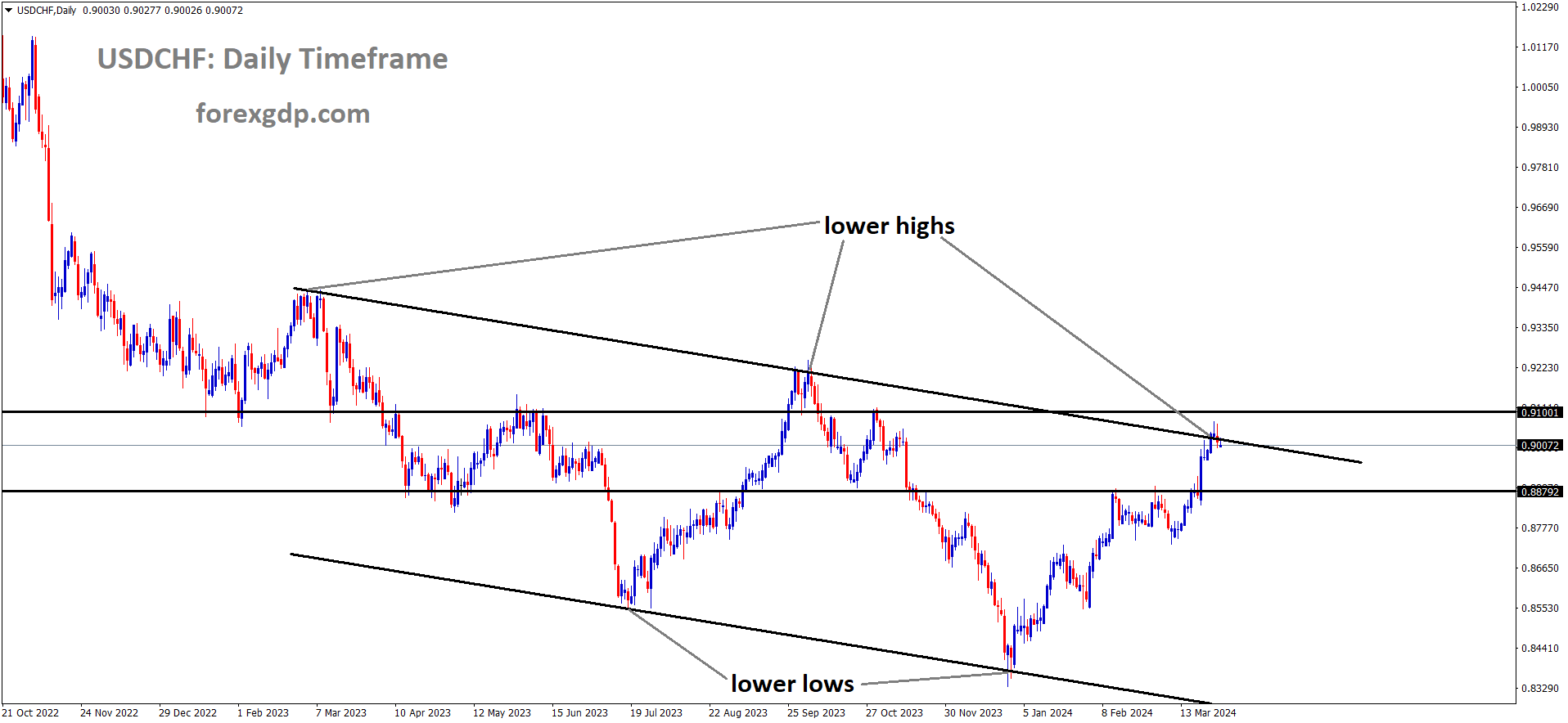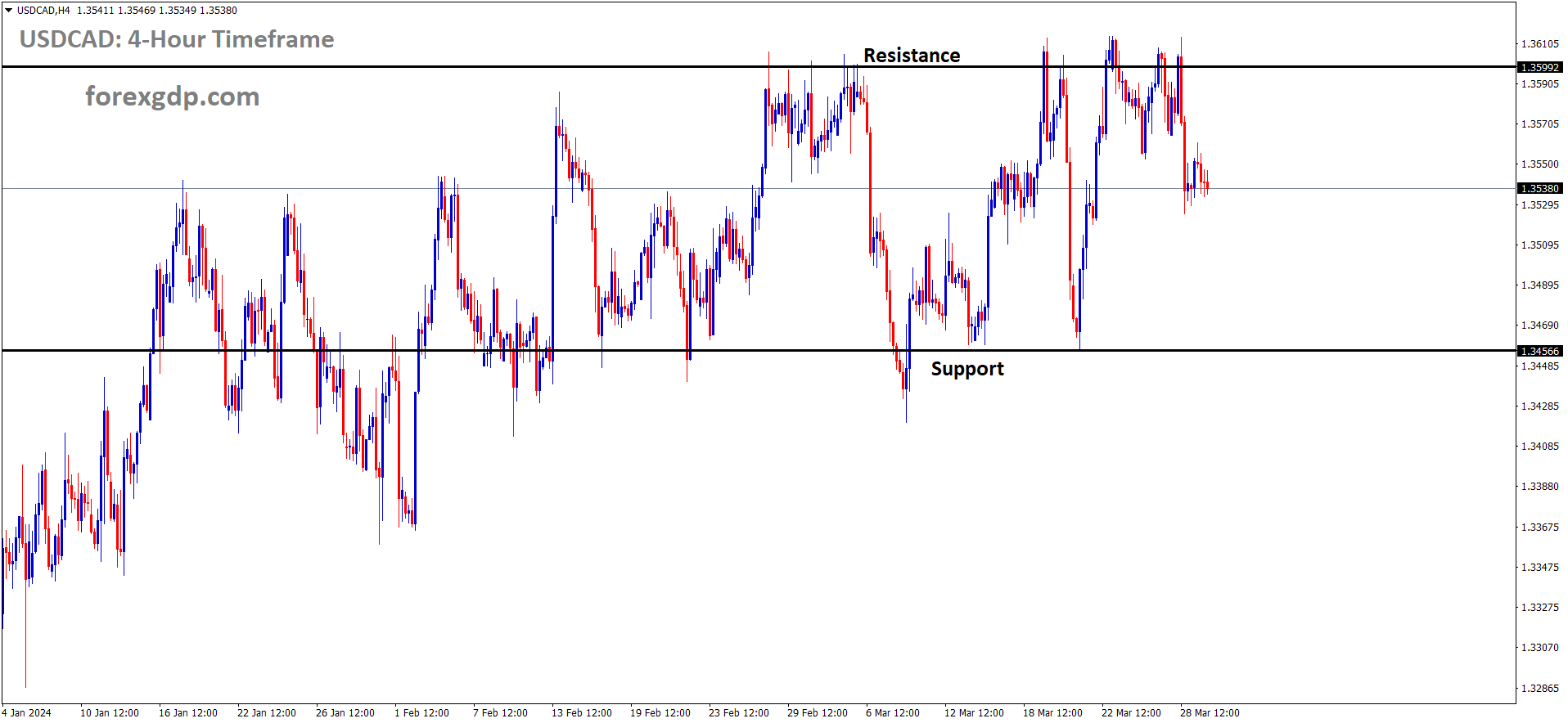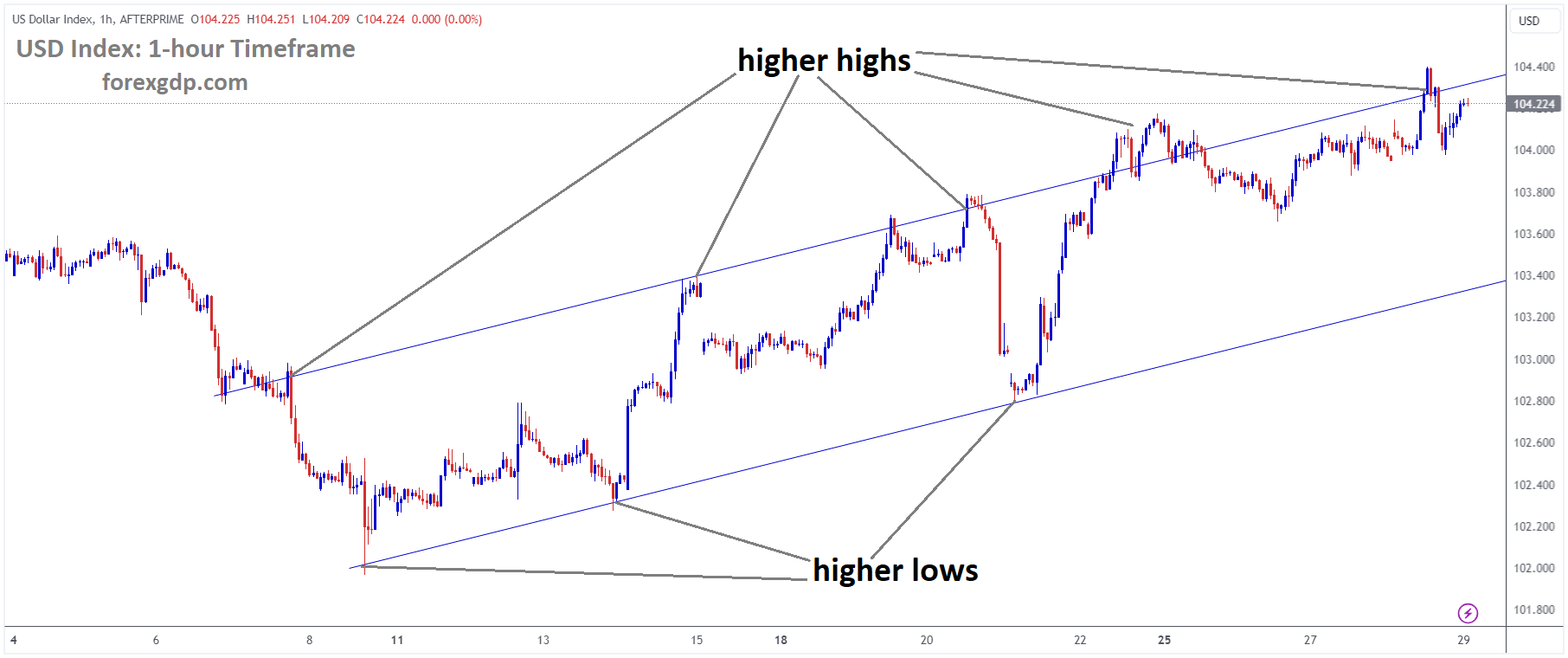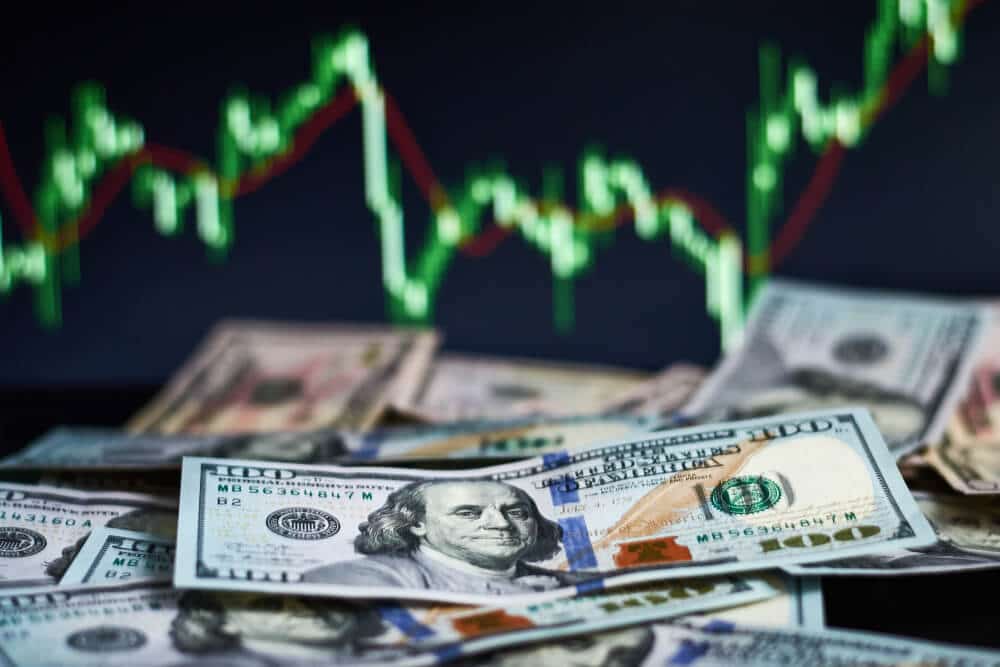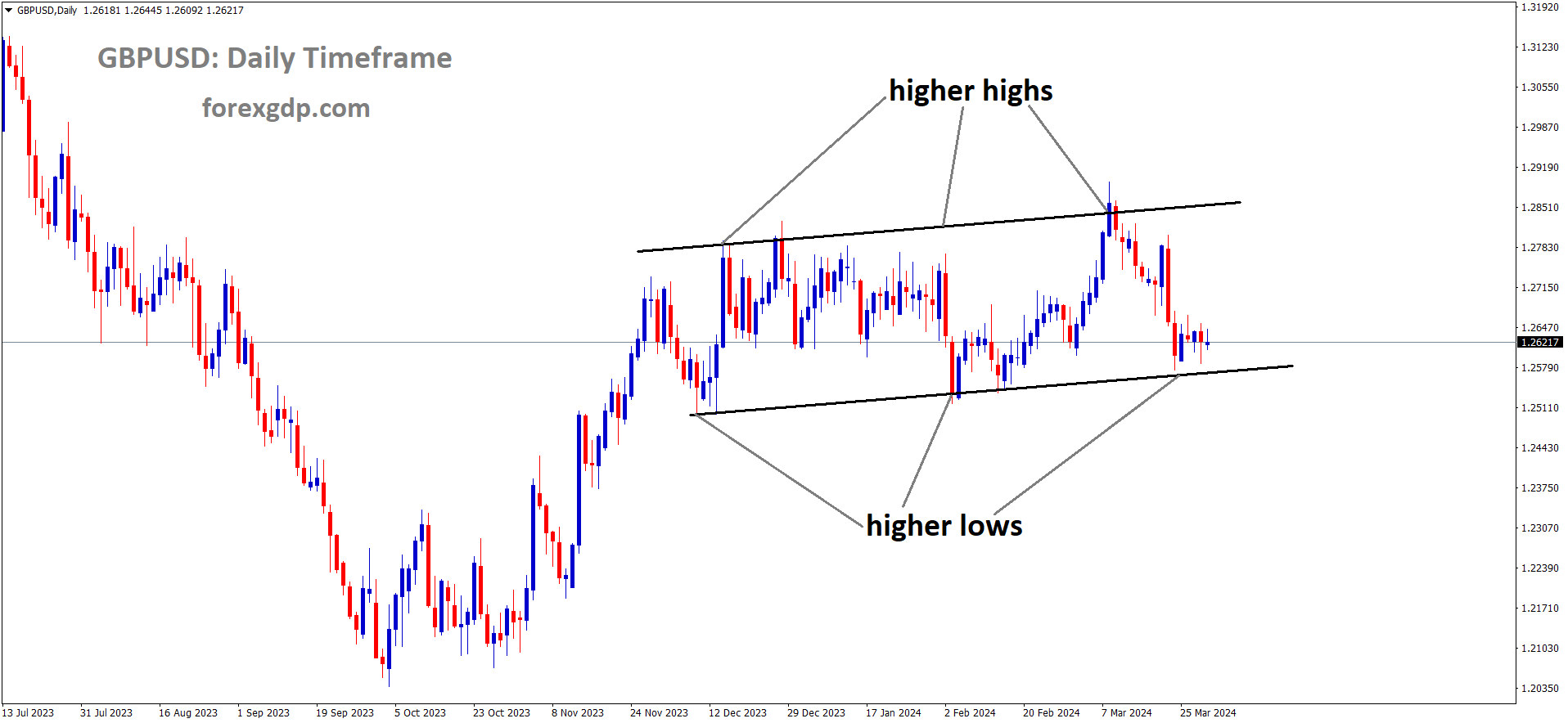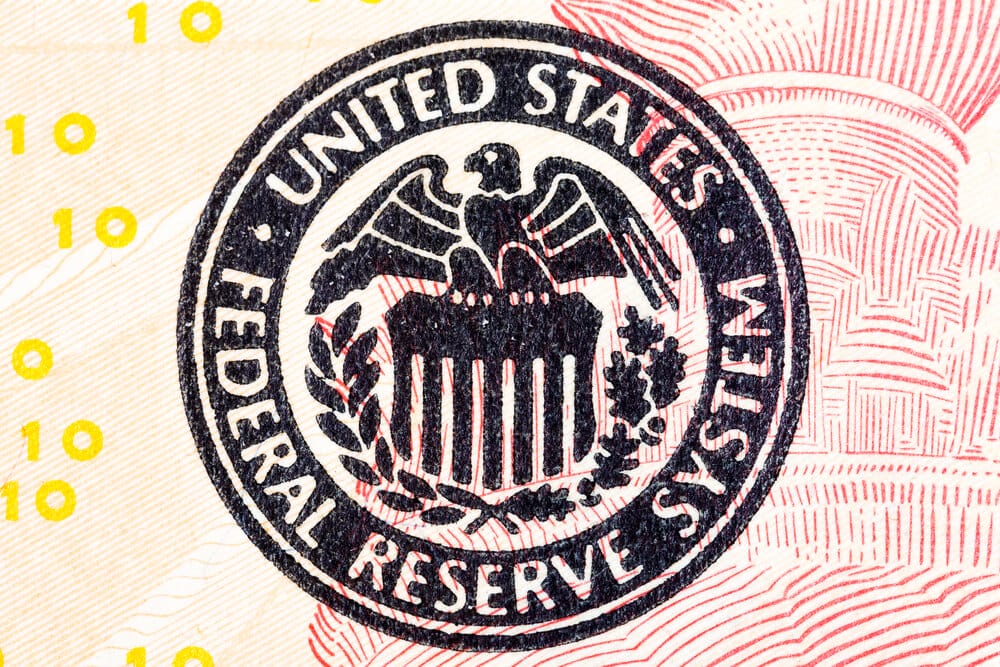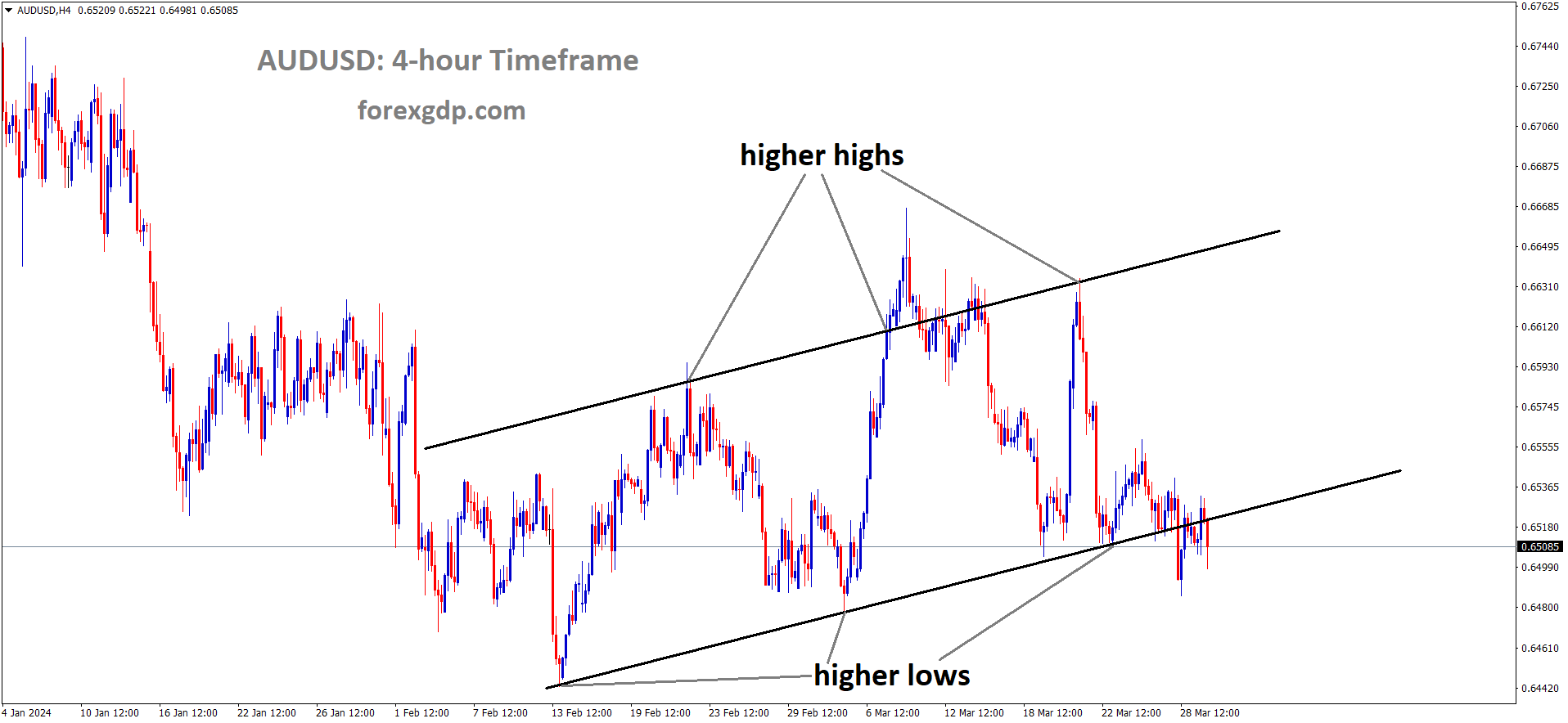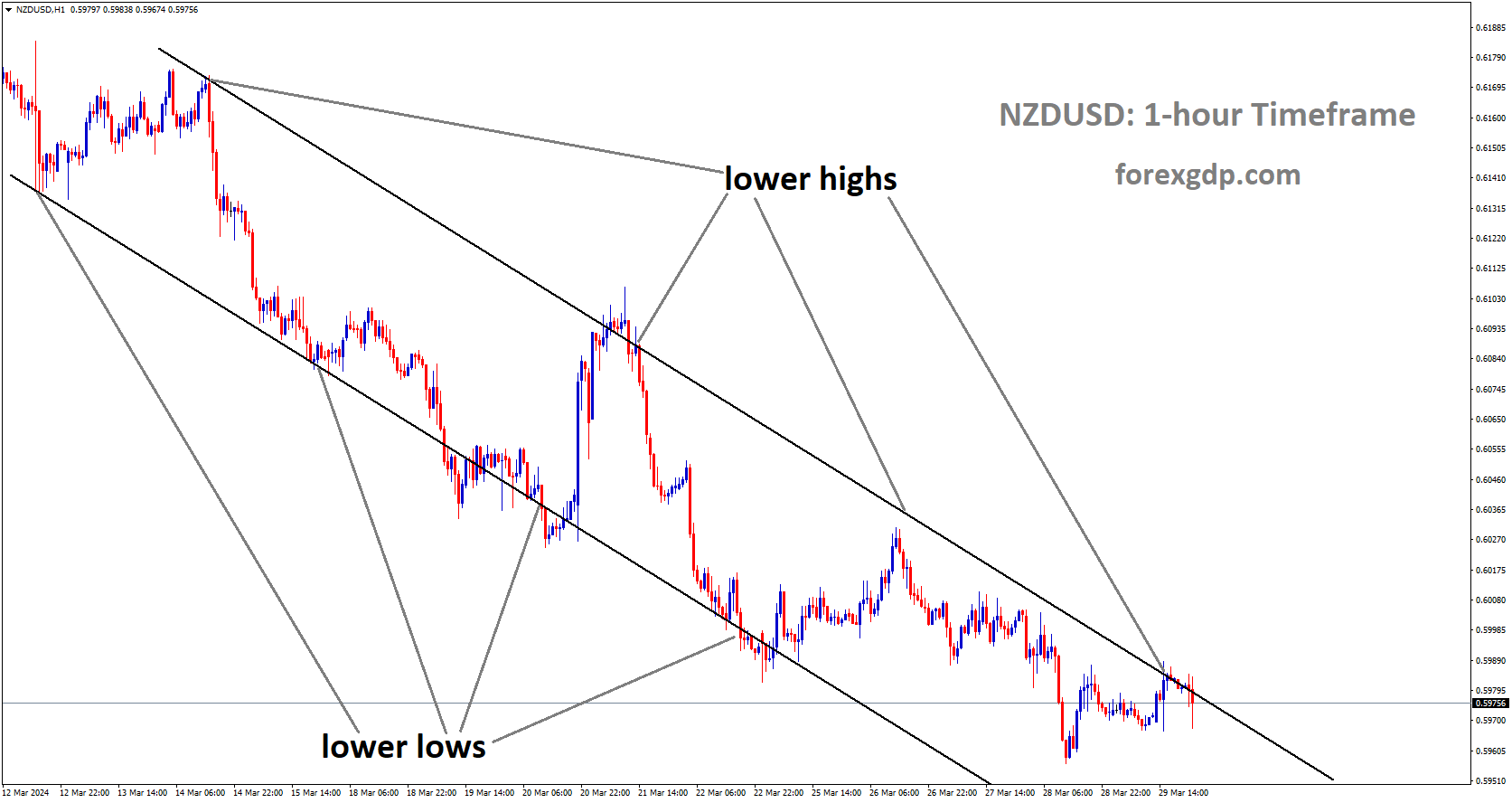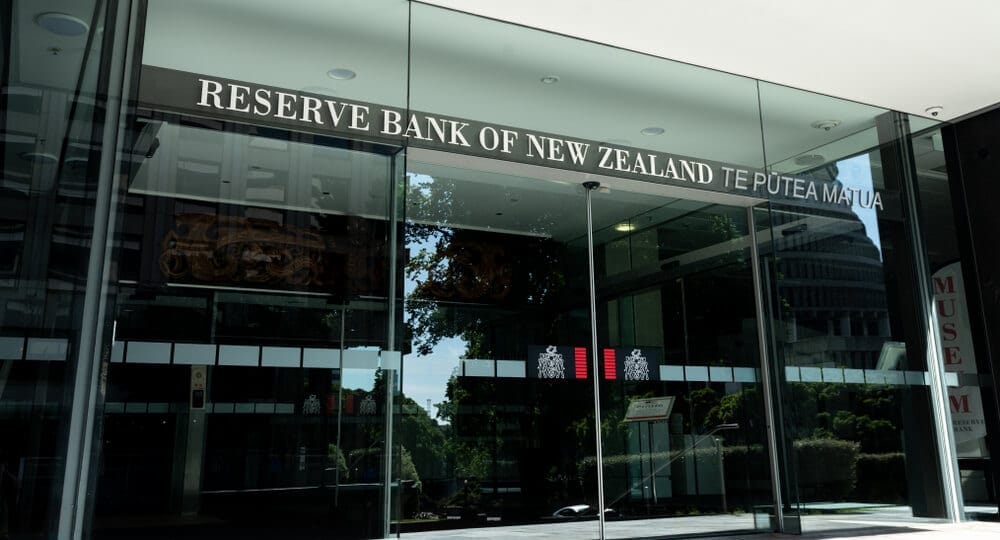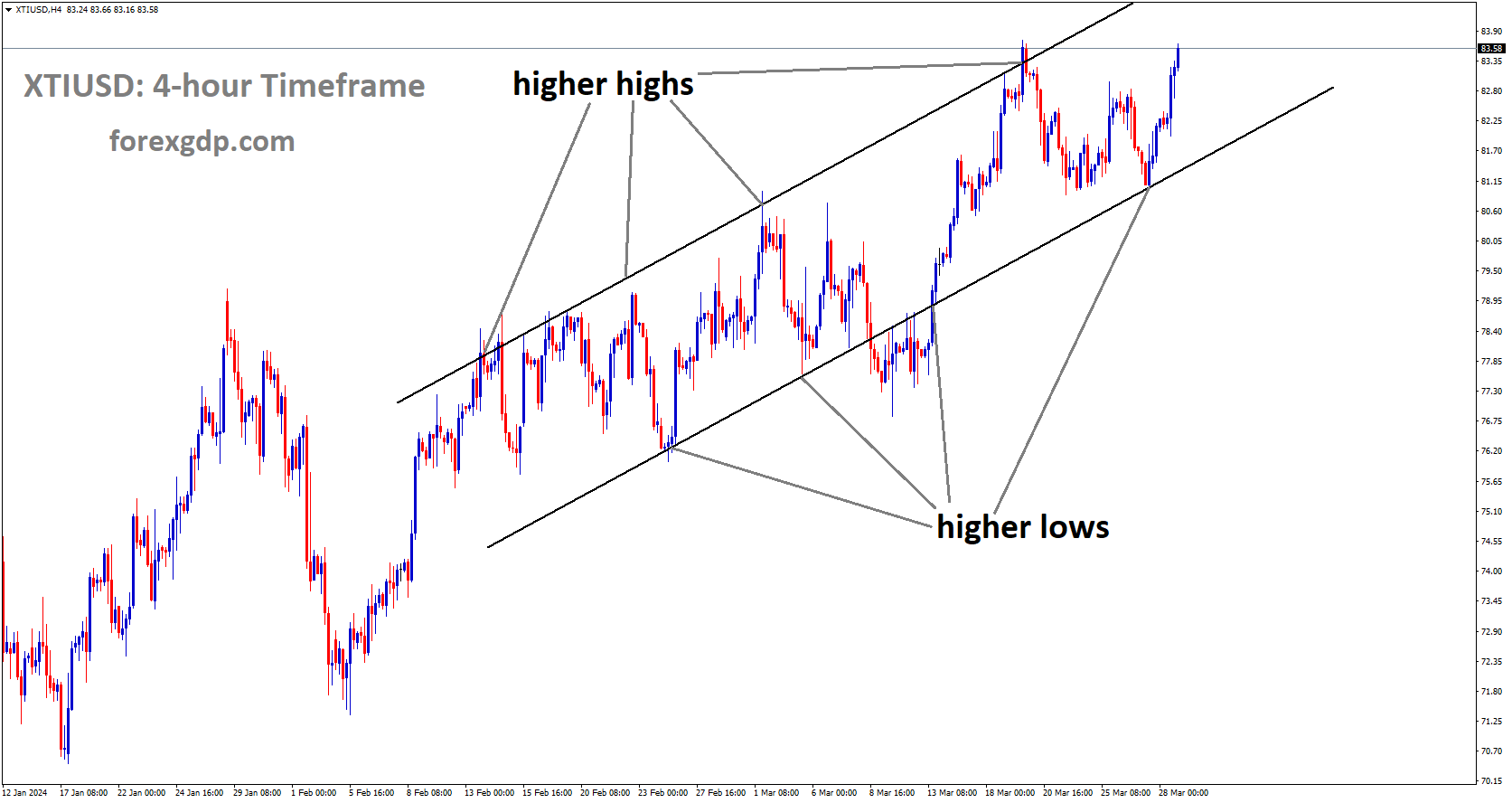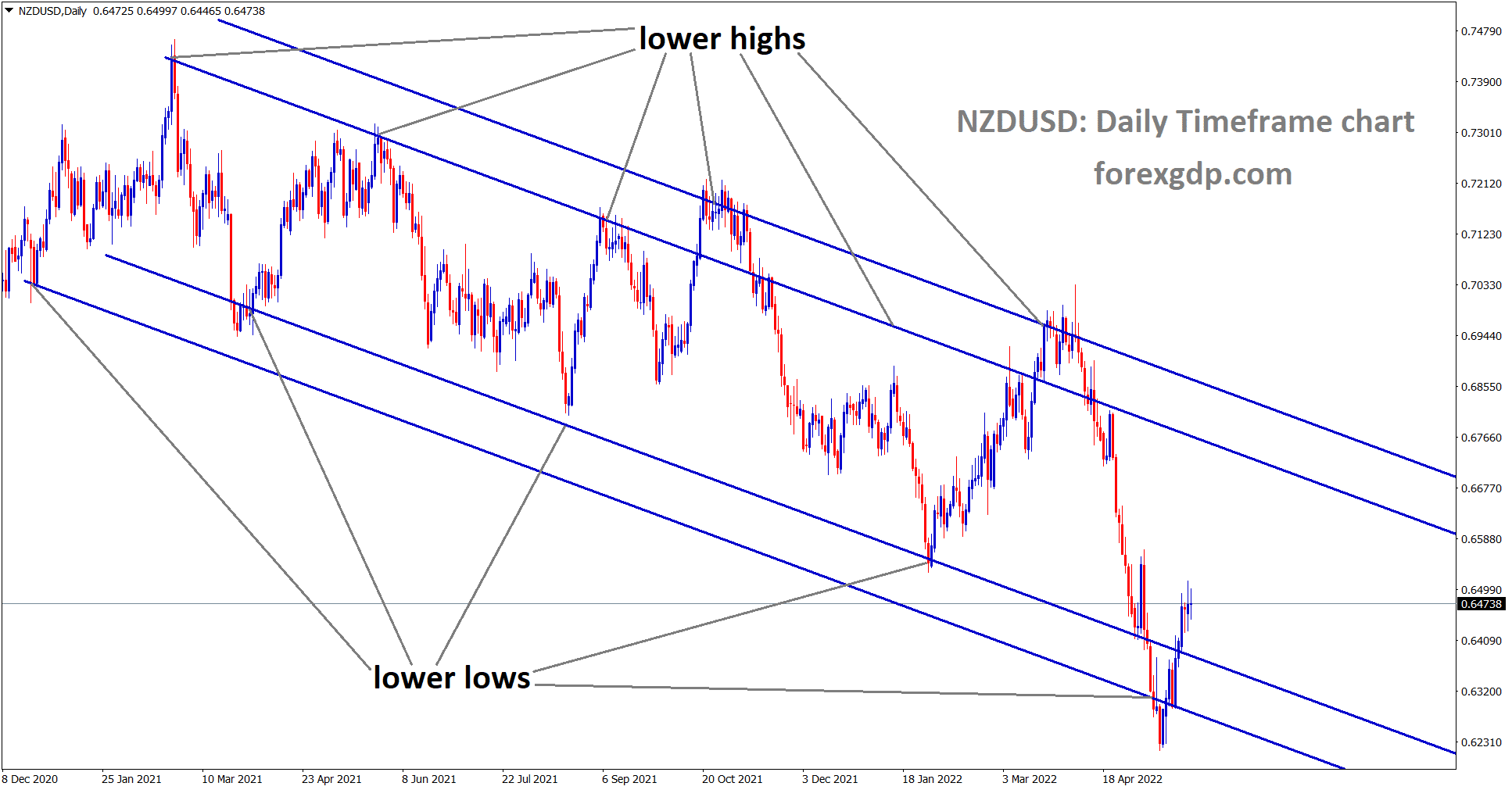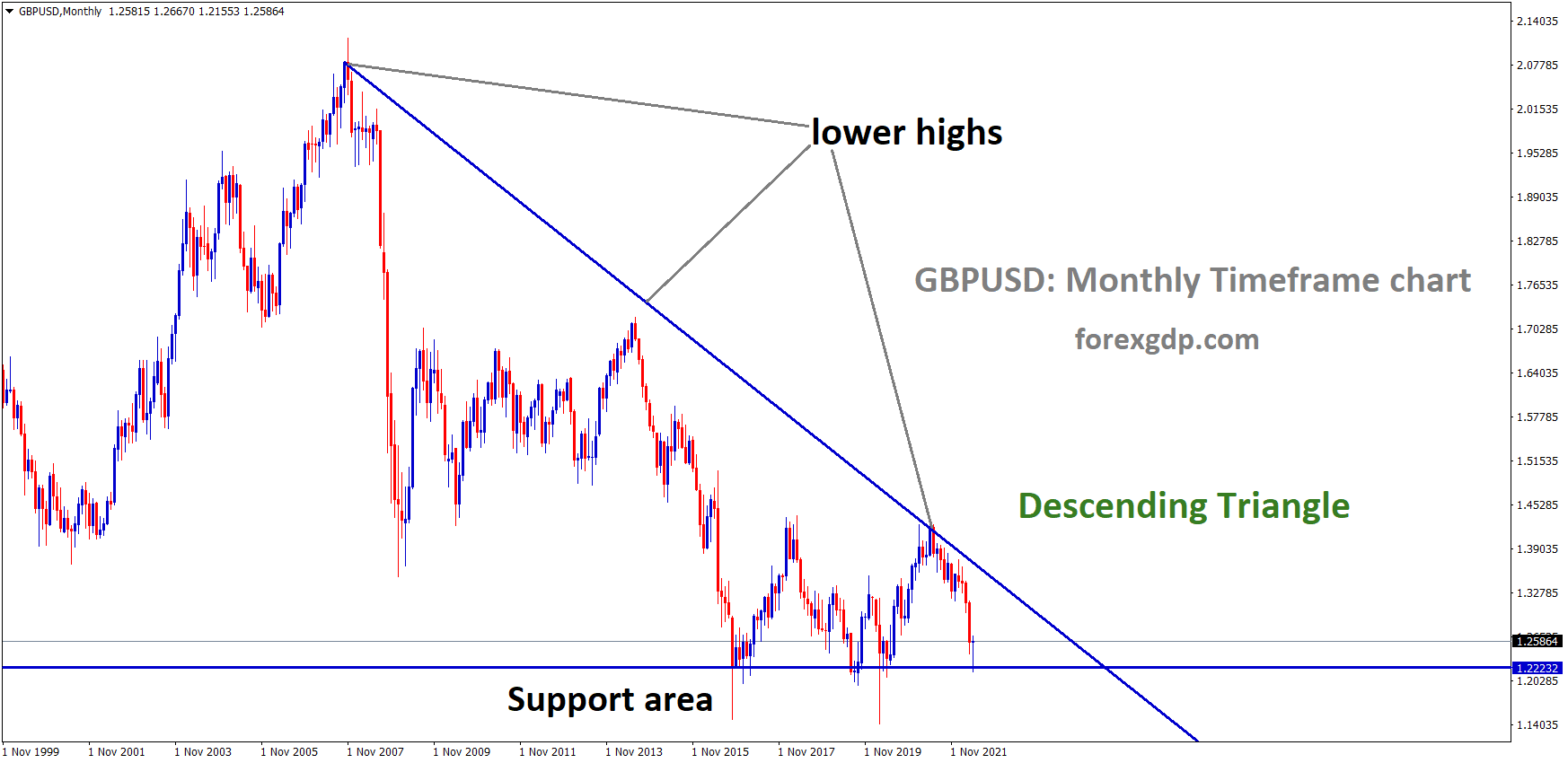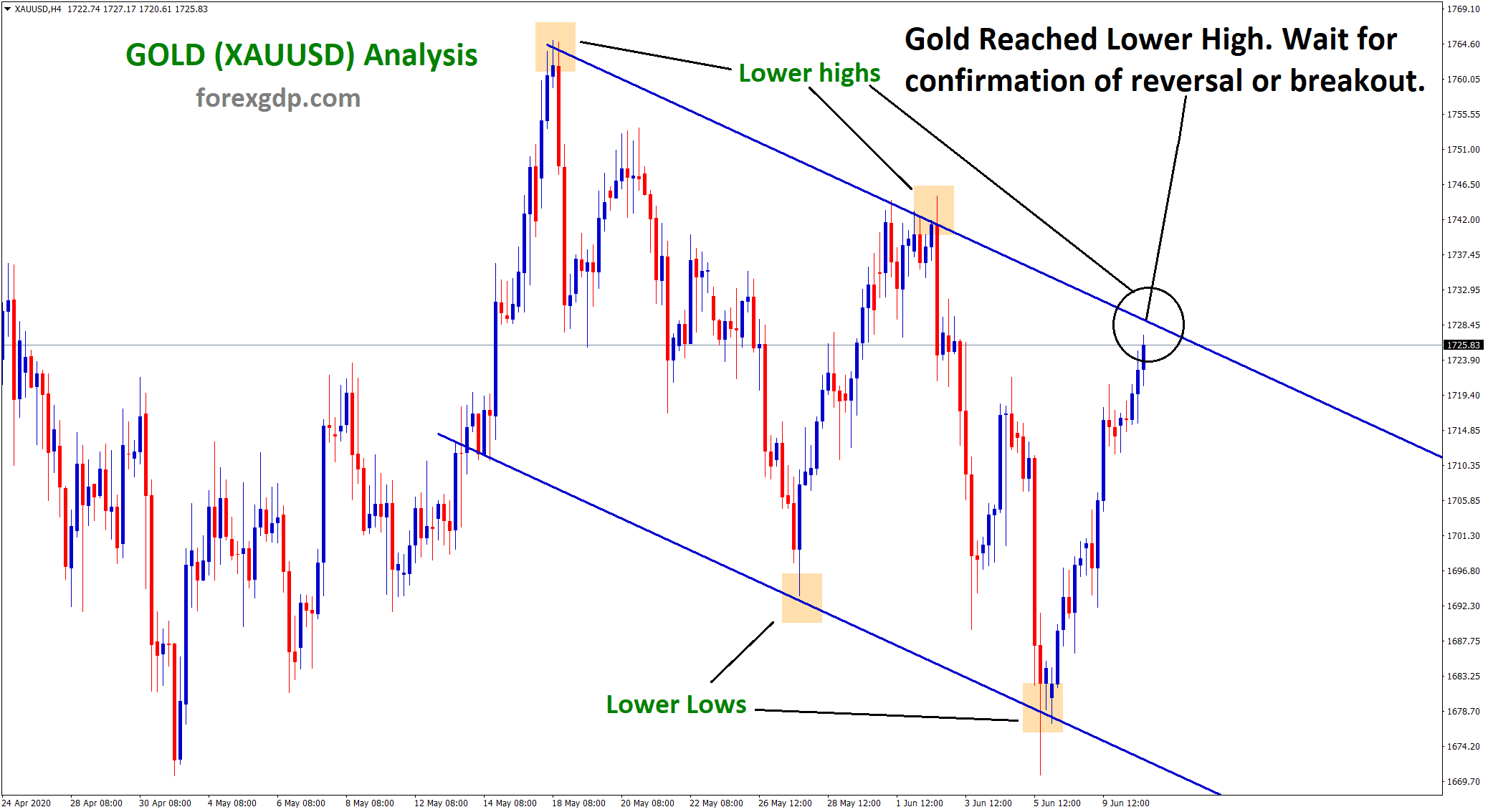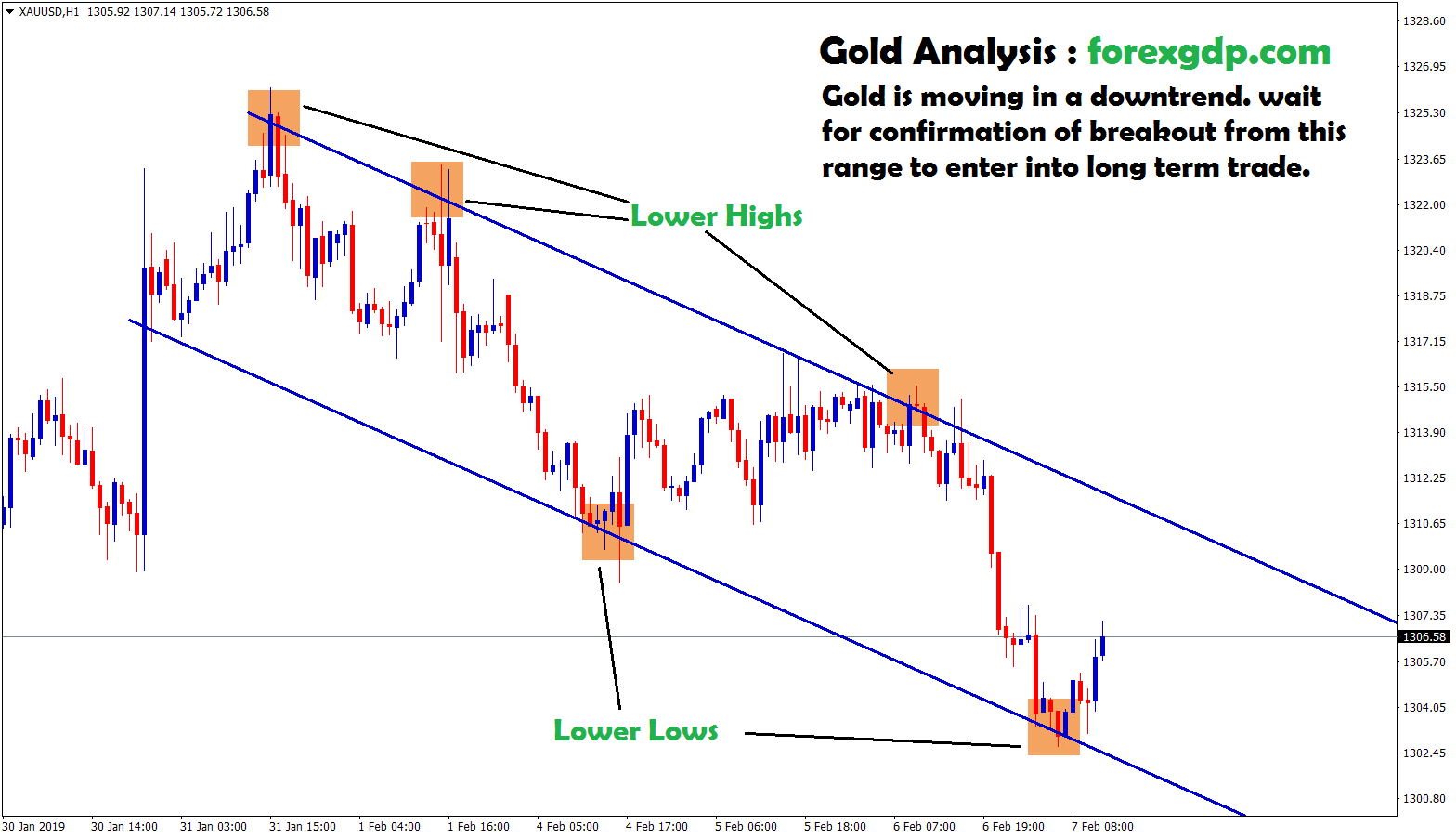XAUUSD – Gold price hits record high near $2,230, US PCE in focus
The Gold prices are moving higher due to Central banks rate cut expectations are higher from economists side. Israel- Gaza war is not stopped till now, this fears of war moved safe haven currencies like USD, Gold to move higher in the market.
XAUUSD is moving in Ascending channel and market has reached higher high area of the channel
The price of gold has surged to record highs, nearing $2,230 per troy ounce, indicating its endeavor to extend its winning streak for the fifth consecutive trading session on Friday. However, market activity remains subdued as trading volumes are light, likely due to the observance of Good Friday. The allure of gold has captivated buyers, with market sentiment leaning towards the expectation of major central banks embarking on an interest rate-cutting cycle throughout the year.
Investor confidence in gold is growing as they anticipate the US Federal Reserve (Fed) to implement three rate cuts in the coming months. Chicago Fed President Austan Goolsbee, adopting a dovish stance, anticipates these cuts but underscores the importance of gathering more evidence of inflation easing before initiating any policy actions.
Furthermore, European Central Bank (ECB) policymaker Francois Villeroy has indicated that achieving the ECB’s inflation target of 2% is feasible. However, he warns of potential escalating downside risks if the ECB opts against implementing rate cuts. ECB executive board member Fabio Panetta echoed similar sentiments, suggesting on Thursday that the conditions for initiating monetary policy easing are gradually emerging.
In Europe, the unexpected decision by the Swiss National Bank to lower rates during its March meeting has sparked speculation that other major central banks may follow suit. Meanwhile, although the Bank of Japan has discontinued its negative rate policy, it is anticipated to maintain an accommodative stance in the near future.
The United Nations Security Council has passed a resolution calling for a ceasefire between Israel and Hamas, as well as the release of hostages. Despite this, the conflict in the Gaza Strip persists without pause, as Palestinian militants have yet to release any captives. According to reports from the Palestinian Red Crescent, Israeli forces have besieged two additional Gaza hospitals, trapping medical personnel amidst heavy gunfire. These escalating geopolitical tensions have led to increased demand for safe-haven assets such as gold.
EURUSD – dips near 1.0770 on ECB hint of June rate cut
The German Retail sales for the month of February came at -1.9% versus 0.30% expected increase, YoY data came at -2.7% decline. The ECB Officials members stated that June month rate cut is more possible due to Euro zone economy is reaching our inflation target of 2% near.
EURUSD is moving in Descending channel and market has reached lower high area of the channel
During the European session on Friday, the EUR/USD currency pair maintains its position near the 1.0770 mark, marking the fourth consecutive day of losses. Trading activity is relatively light, likely due to observance of Good Friday, contributing to the subdued market movement. The euro continues to face downward pressure, partly attributed to indications from European Central Bank (ECB) officials hinting at a potential interest rate cut in June.
Adding to the euro’s challenges, Germany’s Retail Sales data for February disappointed expectations. The monthly report showed a 1.9% decline in retail sales, contrary to the anticipated 0.3% increase, with a corresponding year-over-year drop of 2.7%.
Yannis Stoumaras highlighted on Tuesday a growing consensus within the ECB for a rate reduction in June. ECB policymaker Francois Villeroy expressed concerns over a rapid decline in core inflation, emphasizing the feasibility of achieving the ECB’s 2% inflation target but warning against increased downside risks without a rate cut. Meanwhile, ECB executive board member Fabio Panetta noted restrictive policies’ impact on demand and inflation decline.
The US Dollar Index (DXY) strengthens, nearing 104.60, supported by recent US economic data showing annualized GDP expansion of 3.4% in the fourth quarter of 2023, surpassing expectations. However, US Core Personal Consumption Expenditures (PCE) for the same period came slightly below expectations at 2.0%.
Furthermore, hawkish statements from a Federal Reserve (Fed) official, Christopher Waller, on Wednesday suggested a potential delay in interest rate cuts due to strong inflation figures. Investors await Friday’s US PCE report, the Fed’s preferred inflation gauge, for further guidance.
USDJPY – holds steady at 151.40 amid cautious BoJ monetary stance
Tokyo CPI Data for the month of March 2024 climbed to 2.6% YoY versus 2.5% came at previous reading. Tokyo CPI ex food, energy came at 2.9% in March month down from 3.1% increase in February month. JPY was down after the data printed. Japanese PM Kishida said we have to go with Bank of Japan policy settings of wage increase inflation cycle is good for our economy.
USDJPY is moving in box pattern and market has rebounded from the support area of the pattern
During the early European trading hours on Friday, the USD/JPY currency pair maintains stability, hovering around the 151.40 level. This calmness follows the release of the Tokyo Consumer Price Index (CPI) for March, which showed a 2.6% year-on-year increase, slightly higher than the 2.5% rise observed in February. However, the Core Tokyo CPI, which excludes volatile food and energy prices, grew by 2.9% year-on-year, down from the 3.1% increase recorded in February.
Japanese Finance Minister Shunichi Suzuki, addressing concerns about currency market volatility on Friday, stressed the importance of stable currency movements aligned with economic fundamentals. He attributed rapid fluctuations in foreign exchange (FX) markets to speculative activities and affirmed authorities’ readiness to take necessary actions to address disorderly FX movements.
Furthermore, Japanese Prime Minister Fumio Kishida, in remarks made on Thursday, supported the Bank of Japan’s (BoJ) stance of maintaining accommodative monetary conditions. Kishida highlighted the government’s commitment to collaborating with the BoJ to promote wage increases and steer the economy away from deflation. This cautious approach by the BoJ likely contributed to challenges faced by the Japanese Yen (JPY), thereby supporting the USD/JPY pair.
In contrast, the US Dollar Index (DXY) strengthens, nearing 104.60, buoyed by recent economic data indicating robust annualized economic expansion in the United States (US), primarily driven by consumer spending. Notably, the US Gross Domestic Product (GDP) Annualized for the fourth quarter of 2023 expanded by 3.4%, surpassing market expectations. Additionally, the US Gross Domestic Product Price Index remained steady with a 1.7% increase, aligning with forecasts for Q4.
The USD’s strength was further reinforced by hawkish comments from a Federal Reserve (Fed) official. Fed Governor Christopher Waller’s remarks on Wednesday hinted at a potential delay in interest rate cuts, given the strong inflation figures, indicating a more hawkish stance from the Fed.
USDCHF – Rebounds above 0.9000 before US PCE data
The Swiss Franc is moving in the losing streak against Counter pairs after the SNB cuts the interest rate last week. SNB VP Martin Schlegel said we have to intervene in the FX market to protect the Swiss Franc, we do not fixing target level of Swiss Franc rate.
USDCHF is moving in Descending channel and market has reached lower high area of the channel
This reversal is driven by hawkish remarks from the US Federal Reserve (Fed) and robust US economic data, which bolster the US Dollar (USD) and provide support for the USD/CHF pair. However, potential gains for the pair may be tempered by the prospect of intervention by the Swiss National Bank (SNB) in the foreign exchange market.
Fed Governor Christopher Waller’s statement on Wednesday emphasized that the central bank was not in a hurry to reduce interest rates, citing persistently high inflation as evidence that current rates require more time to have an impact. Additionally, Fed Governor Lisa Cook expressed on Monday the importance of a cautious approach to policy shifts to ensure a sustainable return of inflation to the 2% target. The prevailing narrative of higher US rates for an extended period could bolster the Greenback and provide support for the USD/CHF pair in the short term.
Conversely, SNB Vice President Martin Schlegel stated on Wednesday that the Swiss central bank would closely monitor exchange rates and intervene in the foreign exchange market as necessary, despite lacking a specific target for the Swiss Franc (CHF) exchange rate. Last week’s surprise decision by the SNB to cut its benchmark interest rate for the first time in nine years triggered CHF sell-offs in previous sessions. Expectations of potential SNB intervention may limit the CHF’s downside against the USD.
Furthermore, escalating geopolitical tensions in the Middle East could benefit safe-haven currencies such as the Swiss Franc. Reports from the Palestinian Red Crescent indicated that Israeli forces had besieged two Gaza hospitals on Sunday, placing medical teams under heavy gunfire.
Later in the day, the market awaits the release of the US Core Personal Consumption Expenditures (PCE) Price Index. The Fed considers this index as its preferred measure of inflation, and it is expected to remain stable at 2.8% year-on-year. Trading activity is likely to be subdued on Good Friday, contributing to muted market reactions.
USDCAD – may end losing streak, holds at 1.3540 on stronger USD
The Canadian GDP data for the month of January came at 0.60% versus 0.40% expected. So Bank of Canada may hold the rates at the next month meeting is possible. US Q4 GDP came at 3.4% versus 3.2% expected makes US Dollar strengthened against Canadian Dollar.
USDCAD is moving in box pattern and market has fallen from the resistance area of the pattern
However, trading volumes are anticipated to be low due to the observance of Good Friday. The recent strength of the US Dollar (USD) can be attributed to the prevailing hawkish sentiment surrounding the Federal Reserve’s commitment to maintaining higher interest rates.
This shift in sentiment is bolstered by recent robust economic indicators from the United States (US). Notably, Federal Reserve Governor Christopher Waller’s cautious comments, indicating no urgency to initiate rate cuts, have tempered market expectations of three anticipated rate reductions in 2024.
In the fourth quarter of 2023, US Gross Domestic Product (GDP) Annualized expanded by 3.4%, surpassing market forecasts of remaining steady at a 3.2% increase. Additionally, US Core Personal Consumption Expenditures (PCE) for the same period showed a modest growth of 2.0%, slightly below both the anticipated and previous reading of 2.1%.
Conversely, the Canadian Dollar (CAD) has received a boost from heightened prospects of foreign currency inflows, driven by the uptick in West Texas Intermediate (WTI) oil prices. The increase in crude oil prices is linked to expectations that the Organization of the Petroleum Exporting Countries and its allies (OPEC+) will persist with their production cuts.
Moreover, Canada’s Gross Domestic Product (GDP) for January expanded by 0.6%, surpassing the projected 0.4% increase. This indicates resilience in the Canadian economy and points towards a strengthening economic landscape. Consequently, these positive economic figures have instilled confidence in Canada’s economic outlook, diminishing market expectations of immediate rate cuts by the Bank of Canada (BoC).
USD INDEX – Powell Affirms: Economy Strong, No Doubt
The FED Powell speech on San Francisco last day is US Economy is growing stronger than expected, Core inflation reading is going towards 2% area. We did not see daily economic calendar and set the rates ups and down.If Labour market going to weakness, then see the Policy will get loose in the market. Consumer spending has to less with inflation target of 2% is more important for our policy cycle.
USD INDEX is moving in Ascending channel and market has reached higher high area of the channel
Federal Reserve Chair Jerome Powell recently engaged in a discussion at the Macroeconomics and Monetary Policy Conference held in San Francisco, where he shared key insights into the current economic landscape. During his discourse, Powell highlighted several noteworthy points:
Inflation Commentary : Powell acknowledged the recent core inflation figures, characterizing them as indicative of tangible progress. He expressed the Federal Reserve’s expectation for inflation to gradually reach the 2% target, albeit possibly encountering some bumps along the way.
Monetary Policy Stance : Powell emphasized the Federal Reserve’s commitment to maintaining the current interest rate stance, particularly if the anticipated economic trajectory deviates from the base case scenario. He suggested that interest rates could remain unchanged for a prolonged period if necessary.
Uncertainty Surrounding Future Rates : Powell admitted the uncertainty surrounding the future trajectory of interest rates, stating that the Federal Reserve lacks definitive clarity on the eventual rate levels once the current economic uncertainties subside.
Economic Resilience : Despite prevailing low interest rates, Powell asserted that the economy remains robust and resilient. He confidently affirmed that the strength of the economy is beyond question, dismissing concerns about an imminent recession.
Labor Market Monitoring : Powell highlighted the Federal Reserve’s vigilance regarding the labor market, indicating that any unexpected weaknesses in this domain could prompt a policy response from the central bank.
Apolitical Decision-Making : Powell reiterated the Federal Reserve’s commitment to making policy decisions independent of political considerations or external pressures, emphasizing the institution’s focus on economic fundamentals rather than political calendars.
In summary, Powell’s remarks provided insights into the Federal Reserve’s perspective on various aspects of the economy, emphasizing its resilience, commitment to gradual inflation normalization, and data-driven approach to monetary policy decision-making.
GBPUSD – edges higher as US PCE figures meet expectations
US Core PCE index data came at 2.5% in February month versus 2.4% printed in January month. Excluding Food and energy, 2.8% increase in the Core PCE index. Core PCE data is increasing makes US FED rate cuts delay in this year. So GBP is weakness in the market against USD.
GBPUSD is moving in ascending channel and market has reached higher low area of the channel
During Friday’s trading session, the GBP/USD currency pair is hovering around the 1.2640 level, showing a modest increase of 0.14% as market participants assess the implications of the recently released US February Personal Consumption Expenditures (PCE) data.
Inflation in the United States saw a slight uptick in February, reaching an annual rate of 2.5% according to the PCE Price Index, the Federal Reserve’s preferred gauge for monitoring inflation. This uptick represented a marginal increase from January’s 2.4% and was in line with market expectations. The index reflected a month-on-month rise of 0.3%, slightly below the anticipated 0.4% increase. Similarly, the Core PCE index, which excludes volatile food and energy prices, also rose by 2.8% annually, aligning with forecasts, and exhibited a monthly increase of 0.3%. Additionally, January’s core PCE figures were revised upwards. This sustained inflationary pressure may influence the Federal Reserve to maintain its current higher interest rate stance. The upcoming employment data will serve as a crucial determinant for future monetary policy decisions, potentially impacting the timing and magnitude of any rate adjustments.
Consequently, robust employment figures could prompt Federal Reserve policymakers to postpone rate cuts beyond June and implement fewer cuts than the previously projected three for 2024. Such a scenario could ultimately support the US Dollar’s strength in the currency markets.
AUDUSD – China’s SAFE to steadily promote financial market opening
The Deputy Head of State Administration Foreign exchange Xu Zhibin said we will prevent Risk in the financial market, we will promote capital account opening, we will promote cross- Border investments. AUDUSD remains flat after the speech happened.
AUDUSD is moving in Ascending channel and market has reached higher low area of the channel
During the annual Boao Forum on Friday, Xu Zhibin, the deputy head of the State Administration of Foreign Exchange (SAFE), outlined the agency’s commitment to steadily promoting financial market opening. Xu emphasized that SAFE aims to improve policies to facilitate cross-border investment, fostering greater accessibility for investors. Additionally, he highlighted plans to further enhance capital account opening, facilitating smoother capital flows across borders. Furthermore, Xu underscored SAFE’s dedication to enhancing risk prevention capabilities, ensuring stability and resilience within the financial system.
NZDUSD – pressured below 0.6000 ahead of US PCE data
The RBNZ Governor Adrian ORR said the inflation is getting back to our target, we do rate cuts earlier in the next year starting. Economists expected August month in this year have rate cuts from RBNZ. The economy data is more down after the rate hike from RBNZ since last year.
NZDUSD is moving in Descending channel and market has reached lower high area of the channel
This decline is primarily attributed to dovish remarks made by Reserve Bank of New Zealand (RBNZ) Governor Adrian Orr, which have weighed on the New Zealand Dollar (NZD). Market participants are eagerly awaiting the release of US February Personal Consumption Expenditures (PCE) data for potential market-moving catalysts.
Recent data from the Bureau of Economic Analysis revealed that the US economy expanded at a faster pace than anticipated in the fourth quarter (Q4), driven by robust consumer spending and corporate investment. The final estimate for US Gross Domestic Product (GDP) growth in Q4 was revised upward to an annual rate of 3.4%, surpassing the previous estimate of 3.2%. This stronger-than-expected data has led to a modest uptick in the US Dollar (USD).
On the New Zealand front, RBNZ Governor Orr remarked that the central bank remains committed to bringing inflation back within the target band. However, he also indicated that interest rates have likely peaked and hinted at potential rate cuts in the near future, possibly starting from early next year. Despite investors pricing in rate cuts from as early as August this year, these comments have exerted downward pressure on the NZD, acting as a hindrance for the NZD/USD pair.
Later in the day, the focus will shift to the release of US Core PCE data, which is anticipated to show a month-on-month increase of 0.3% and a year-on-year increase of 0.8% for February. A stronger-than-expected report could further bolster the USD. Additionally, speeches from Federal Reserve Chair Jerome Powell and Federal Reserve Bank of San Francisco President Mary Daly are scheduled, potentially providing additional insights into the central bank’s monetary policy outlook.
CRUDE OIL – Oil Poised for $90 Despite Near Full US Production
The Crude Oil prices are like to higher in upcoming days due to US Energy department is going to buy at lower prices to rebuild 40 year low of US Strategic reserves. Dump at lower prices and sale at higher prices is the US Oil Business strategy follows now. US Core PCE index came at 2.5% in February from 2.4% in previous month boosted US Dollar in the market, at the same time Crude Oil prices are moved up due to Oil demand.
XTIUSD is moving in Ascending channel and market has rebounded from the higher low area of the channel
Oil prices have surged recently, reflecting a complex situation in the global oil market, particularly concerning the United States. Initially, bearish movements were attributed to the US flooding the market to lower prices. However, recent reports from Bloomberg indicate that the US Energy Department is actively purchasing oil at current prices to replenish strategic reserves, which were at a 40-year low. This paradoxical situation sees the US selling oil to drive prices down while simultaneously buying it back at higher prices.
Simultaneously, the US dollar has seen a resurgence, with bullish sentiment driving a four-day winning streak ahead of the release of the US Personal Consumption Expenditures (PCE) Price Index. This comes amid growing concerns over inflation, with recent measures indicating upward pressure on prices. A significant uptick in inflation revealed by the PCE could prompt markets to reassess expectations for interest rate cuts from the US Federal Reserve, potentially delaying the anticipated rate cut.
As of Thursday, Crude Oil (WTI) closed at $82.82 per barrel, while Brent Oil closed at $86.82 per barrel. Despite these levels, there’s a possibility for oil prices to climb further, potentially reaching $90, as US efforts fail to counteract OPEC production cuts. OPEC is expected to discuss and likely extend current production cuts in an upcoming meeting next Wednesday, with Saudi Arabia anticipated to maintain its commitment until the year’s end.
Meanwhile, despite Easter Monday, the US Energy Information Administration will proceed with its regular release of US stockpile changes on Wednesday, while the American Petroleum Institute will provide overnight figures on Tuesday. Additionally, reports indicate that several oil tankers are stranded off the coast of Venezuela, posing challenges for traders who capitalized on the easing of sanctions against the country but are now unable to load their vessels.
Don’t trade all the time, trade forex only at the confirmed trade setups.
Get more confirmed trade setups here: forexgdp.com/buy/


